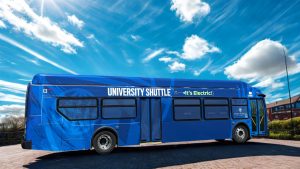JHU Electric Buses

JHU Goes Electric: Cleaner Campus Transit
A Milestone for Sustainable Transportation
This fall, Johns Hopkins will introduce five brand-new electric buses to the Homewood–Peabody–JHMI shuttle route—a major step forward in JHU’s university-wide commitment to sustainability, innovation, and improving the rider experience.
These state-of-the-art vehicles will:
- Reduce our carbon footprint
- Modernize our shuttle fleet
- Provide a quieter, cleaner, and more efficient way to travel between campuses
Why it Matters
- Zero tailpipe emissions mean cleaner air for our community
- 110 tons of greenhouse gases are avoided annually per bus compared to diesel
- Much quieter operation with a smoother ride
- Supports JHU Climate & Sustainability Action Plan goals (10.1 & 10.2)
Celebrate With Us! 🎉
On Wednesday, October 15, from 11:30 a.m. to 1 p.m., behind Shriver Hall, we will celebrate the launch of the new electric buses. The launch includes light refreshments, giveaways, a ribbon-cutting ceremony, bus walk-throughs, and the first bus ride around campus. It’s more than a bus launch—it’s a celebration of our community moving toward a greener future together.
Send Us Your Bus Pics! 📸
We want YOU to be a part of this milestone! Snap a photo with the new electric bus—or riding inside—and share it with us on Instagram, @jhusustainability. Don’t forget to use the hashtag: #JHUGoesElectric.
Meet the Bus: Fast Facts
-
New Flyer XE40
- The XE40 is the 40‑foot battery‑electric version of New Flyer’s Xcelsior Transit Bus
- The “CHARGE” / “CHARGE NG” versions represent next‑gen enhancements: lighter, more efficient, better energy recovery.
- JHU ordered five (5) XE40 buses as part of an initial deployment
-
Power & Performance
- Uses Siemens electric drive system (traction motor)
- Power: ~160 kW base, up to 210 kW optional.
- Top speed: ~65 mph (105 km/h).
- Range: up to ~254 miles (408 km) depending on battery size, load, and route.
- Regenerative braking extends range.
-
Battery & Energy
- JHU’s buses are equipped with 520 kWh energy storage capacity, contained in 6 ‘modules’ – 4 on the roof and two in the back, where a diesel engine would normally be found
- Range is dependent upon multiple factors (including load, temperature, and driving style), but JHU’s units should be able to operate 16-18 hrs before recharging (1-2 shifts)
-
Bus Dimensions
- Length: 40 ft, Width: 102 in (8.5 ft), Height: ~10.8 ft.
- Curb weight: ~30,500 lbs. (13,840 kg).
- Perimeter seating for 33 + standees
-
Environmental Benefits
- Zero tailpipe emissions.
- Helps avoid up to 110 tons of GHG emissions per year (vs diesel).
- Much quieter operation; vehicles will operate the Homewood-Peabody-JHMI route
- Will contribute to meeting JHU’s Climate Sustainability Goals 10.1 & 10.2
The Journey to Electrification
Johns Hopkins began its move toward electric buses in 2020, when Transportation Services sought a new operator for the Homewood–Peabody–JHMI shuttle route and asked bidders to consider both diesel and electric options.
Academy Bus—experienced in EV operations—won the contract. As supply chain challenges and rising interest rates emerged post-COVID, JHU decided to purchase the buses outright and lease them to Academy to operate.
The university selected New Flyer as the manufacturer. The buses were built in St. Cloud, Minnesota, and equipped with Gen 3b battery technology (520 kWh per bus). To support charging, two 120 kW DC fast chargers from Evesco were installed at Academy’s South Baltimore yard.
Together, these steps mark JHU’s next big move toward a cleaner, more sustainable future in campus transportation.
Tell Us About Your Ride
Take a ride on the new electric buses and let us know what you think! Use the form below to leave us your feedback regarding any of our shuttles. Every submission helps make campus transportation better for everyone.